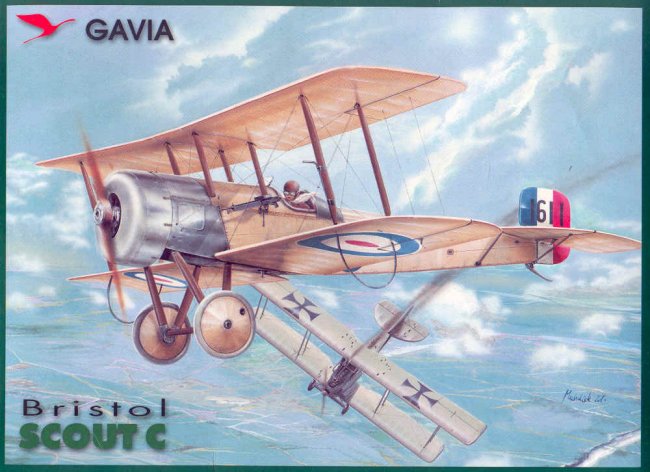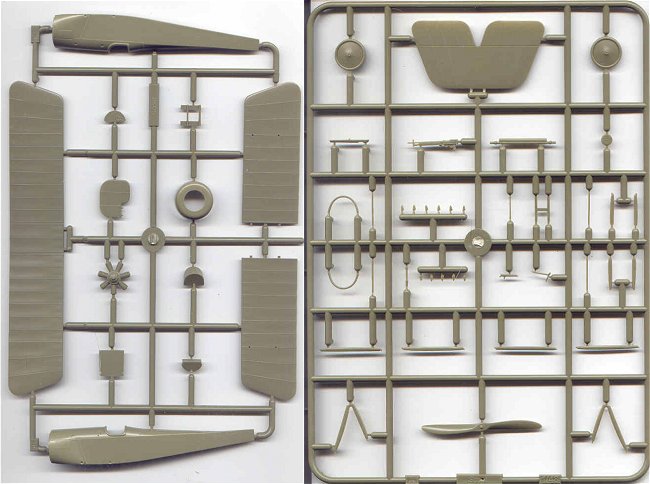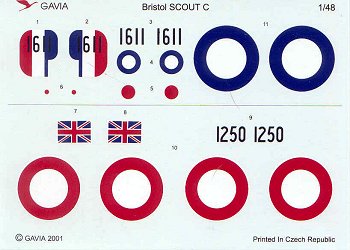
|
KIT: |
Gavia 1/48 Bristol Scout C Preview |
|
KIT # |
006/0501 |
|
PRICE: |
$34.95 |
|
DECALS: |
Two aircraft |
|
REVIEW & |
|
|
NOTES: |

|
HISTORY |
The Bristol Scout was originally designed in 1914 in response to an Italian Army request for an agile single-seat scout aircraft (this was in the days before air combat, so it really was meant to be a "scout"). The SB5 was a monoplane, and was taken on charge by the Royal Flying Corps on the outbreak of war as the Bristol Scout "A." Two more followed as the Bristol Scout "B," before the appearance of the biplane Bristol Scout "C." Given the low power available from the 80 horsepower Gnome-LeRhone engine, the biplane configuration provided more maneuverability and overall better performance. 161 Bristol Scout "C" airplanes were manufactured, and flew with both the Royal Flying Corps and the Royal Naval Air Service.
The airplanes were frequently used as escorts for the two-seat reconnaissance aircraft, particularly after the appearance of the armed Fokker monoplane, when they were forced to become one of the first British fighter aircraft alongside the Martinsyde "S." At first, pilots carried pistols, since at the time the British did not have an interrupter gear; later the Scout was armed with a Lewis gun set to fire forward at an oblique angle past the prop, which made things difficult for actual air fighting. Fortunately, neither side knew anything about tactics, and the opposition was frequently unarmed other than for a single-shot Mauser carbine, so the problem was not insuperable.
Britain's first ace, Captain Lanoe Hawker, flew the Bristol Scout "C" during 1915, during which time he shot down several German two-seaters and was awarded the Victoria Cross for his actions.
|
THE KIT |

 This Gavia kit was
produced by Eduard, and is fully up to the standards of recent releases from
both companies as regards production quality and design. Two sprues of
khaki-colored plastic have the parts, and decals are provided for two different airplanes,
one being No. 1611, flown by Captain Lanoe Hawker on his VC flights.
This Gavia kit was
produced by Eduard, and is fully up to the standards of recent releases from
both companies as regards production quality and design. Two sprues of
khaki-colored plastic have the parts, and decals are provided for two different airplanes,
one being No. 1611, flown by Captain Lanoe Hawker on his VC flights.
The parts are crisp and flash-free, with an excellent representation of fabric covering that does not resort to the traditional "hills and valleys," which were never the way fabric-covered airplanes ever looked.
|
CONCLUSIONS |
This is a simple design, and looks to be an easy project. It would be an excellent candidate for someone considering dipping their toe in the World War One modeling pool for the first time, while experienced World War One modelers will enjoy the design and the opportunity to include an important airplane in their collection.
If you would like your product reviewed fairly and quickly by a site that averages over 2,800 visits a day, please contact me or see other details in the Note to Contributors.